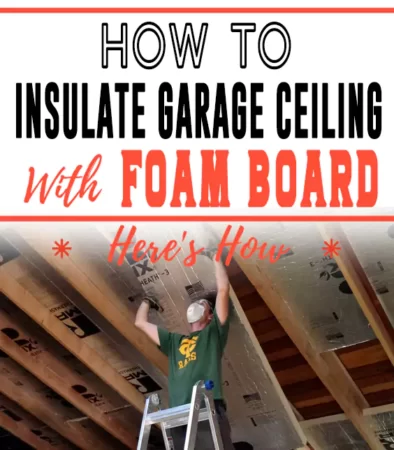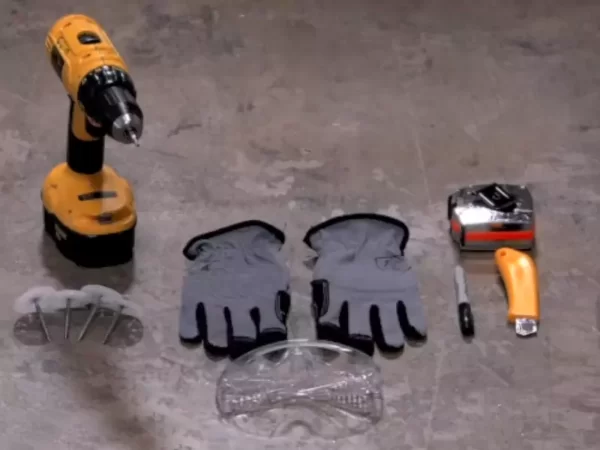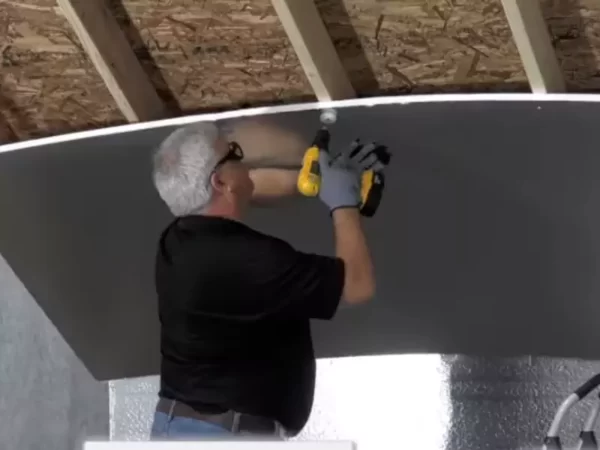Garages can be chilly or sweltering places, especially if the ceiling and/or garage doors are not insulated. To make the garage a more comfortable place, you can check if the garage doors are insulated and add insulation to the ceiling.
Many people use foam boards to add insulation to garages. Foam boards are a common technique for home insulation. However, you’ll have to take your climate into account when deciding which type to purchase.
As you probably know, moisture is more problematic in some places than others. The last thing you want is to install a ceiling insulation material that cannot resist moisture. This consideration is imperative if you live in a humid region.
In the following sections, I explain the details about foam boards and garage ceiling insulation.
I have also included other alternative insulation techniques that would work for a garage.

Can You Insulate a Garage Ceiling With Foam Board?
Absolutely, yes. There are three main considerations in choosing a ceiling insulation material – insulation efficiency, moisture control, and air leak prevention.
As regards insulation efficiency, foam boards have higher R-values than other materials. Foam boards can give an R-value as high as 8.0. The best you can get from plywood and fiberglass insulation are 1.25 and 3.14, respectively.
Foam boards have inherent moisture control properties. And for air leak prevention, foam boards are also reliable air barriers. With these features, you can generally trust foam boards to make a good match for your garage ceiling.
How to Insulate a Garage Ceiling With Foam Board
Garage foam board insulation is often considered a roof expert’s work. Even though the processes are technical, they are not as difficult as people think.
Tools Required
- Foam boards
- Vapor barrier (optional)
- Staples
- Staple gun
- Sealant/sealant gun (expanding foam)
- Drill / driver
- Screws
- Step ladder or scaffold
- Measurement tape
- Drywall tape
- Construction knife or similar for cutting foam
- Safety kits (a pair of safety gloves, goggles, and face mask)
Now that we’ve identified the tools, let’s get into the nitty-gritty of the processes.
Step One: Wear Your Safety Kit

Whether you are a pro or novice with roof work, safety is vital in construction. Before you start handling any tools, wear your safety gear. After this, it’s time to prepare the the ladder.
Step Two: Prepare the Stepladder
Find a level floor surface in the garage to stand the step ladder. It is important to use a flat surface so the ladder doesn’t tilt while climbing. Now that you have access to the ceiling, the next step is to seal all openings.
Step Three: Remove Existing Drywall (If Any)
If your garage ceiling is finished with drywall, carefully detach the boards from the ceiling joists. Once the drywall is down, you’ll be able to determine if there is insulation in your garage ceiling already. You should be able to see if there are already foam board installed.
If you can access the area above the drywall ceiling from another place, you probably don’t have to remove the drywall. You can just access the area above the drywall that requires refinishing.
Step Four: Block Gaps and Holes
Before installing the foam boards, it is necessary to close all openings to reduce unwanted airflow and keep out pests. So, climb through the ladder and check for gaps and holes.
Identify the spots and fill them with expanding foam insulation. While sealing the gaps, be careful to leave out all existing vents. In the long run, you will still need them for air circulation.
If you haven’t worked with expanding foam before, consider getting a Great Stuff Foam Sealant Kit*. It comes with a gun, two cans of sealant, cleaner and safety gloves.
Step Five: Create Air Gaps Under the Roof
Plus the existing vents, you need air gaps to insulate garage ceiling rafters and other roof members.
If you seal everywhere with insulation, it is only a matter of time before having moist and mold build-up on your ceiling. You need baffles around the roof edges to maintain sufficient airflow under the roof.
Some areas may have requirements for how large the baffles need to be. It would be wise to check with your city or country to see if there are any local regulations.
Step Six: Prepare for the Foam Insulation

There are two routes to installing foam board insulation in garage ceiling. You can install it from under if your garage ceiling is unfinished. However, if it is finished, you may have to go through the attic. Let’s look at each.
Option One: Unfinished Ceiling
To insulate an exposed garage ceiling, measure the space intervals between the joist and cut foams to shape. Next, butt-join them under the roof to flush with the ceiling joist’s base.
For safety reasons, leave a minimum clearance of three inches around all electrical fixtures. Check the specifics of your local codes to know if there is a need for baffles around those offsets.
You can cut clearing gaps in the boards if there are surface wirings.
Also, staple vapor barriers to the joists’ soffits with your staple gun.
Option Two: Finished Ceiling
Pick some plywood sheets strong enough to support your weight and climb above your garage. You can leave the plywood sheets if you think you can stand on the joists throughout.
Now lay the foam boards with the same approach for the unfinished ceiling.
Step Seven: Install the Foam Boards
After installing the vapor barriers, the next step is attaching foam board to ceilings. It would be best if you measured the spaces before cutting the panels.
Afterward, carefully drill the boards into the ceiling joists. Finally, finish all the board joints with drywall tape.
Types of Insulation: What Insulation Can I Use For Garage Ceiling?
Now, let’s peek at other options for garage ceiling insulation.
Fiberglass Insulation
Fiberglass is a contemporary insulation technique that tends to be more aesthetically pleasing.
Pros
- Classic and less costly
- DIY-friendly
Cons
- Toxic and highly flammable
- Ineffective moisture control
Foam Core
Foam core insulation uses foam to create air tightness between the garage ceiling installation panels.
Pros
- High R-values
- DIY-friendly
Cons
- Inhibits airflow
- Prone to rodent and pest attacks
Air Sealing Insulation
Air sealing insulation seeks to reduce air leakage within a room space.
Pros
- Highly effective home insulation option
- The processes are DIY-friendly
Cons
- Requires more time
- Door insulation may impair garage functionality
Other options include spray foam and cellulose insulation.
So, what should you consider in choosing?
● R-value
The R-value depends on the roof design and the requirements of your local codes. It would be best if you check for your local code’s specific.
● Sustainability
Sustainability considers two basic metrics – moisture control and air leak prevention. As we’ve seen, all insulation types have varied sustainability performances.
● Ease of Installation
If you are not a roofing expert, you may want to consider a DIY-friendly alternative.
● Cost
Consider the cost, so you choose a technique within your budget.
What Is The Best Insulation For Garage Ceiling And Why?
Although there are other effective insulation options, foam board insulation gives you more than you need.
First off, it has a good R-value. R-values determine the heat retention capacity of an insulation option. A higher R-value is better insulation for the room space.
Another great feature about foam boards is that they are easy to install. You can cut both the foam and panels to fit the space between ceiling joists.
The tasks are pretty easy with or without a helping hand. Also, it has the added advantage of soundproofing. Best of all, it is cheap to install.
Do You Need a Vapor Barrier When Insulating a Garage?
There are no hard and fast rules to deciding whether or not to use a vapor barrier.
Vapor barriers primarily protect the ceiling against moisture effects – conversation and humidity. If you live in an area with condensation and humidity, you may need to include a vapor barrier in your insulation.
Improper moisture control could impair the structural strength of the building foundation, so sometimes it’s safer to install it even if you’re not sure if you need it.
Vapor barriers are also significant to ceiling insulation if you intend to use either heater or air conditioner in your garage.
Cheap Ways To Insulate Garage Ceiling
Due to preference or financial constraints, you may want to experiment with cheap materials with lower R-levels. Let’s wrap it up with ideas for cheap garage ceiling insulation.
● Seal All Air gaps
Air gaps are the greatest culprits of energy loss in buildings. Even insulation material with the highest R-level will still be ineffective if there are openings.
In a garage, your top concerns should be the roof, the windows, and the doors. Seal all gaps.
● Use Good Insulation Materials
After sealing air gaps, use suitable insulation materials. Of course, the point here is not exactly about cost. You’ve probably heard that “price doesn’t always equate to quality.” There are low-cost insulation materials with decent R-levels. Alternatively, you could improvise additional insulation layers using pieces of old clothes in your wardrobe.
● Estimate The Materials Needed
Another way to navigate slim budgets is to estimate the materials needed before buying. Measure the area of your garage roof and calculate what quantity of boards, foams, and vapor barriers are required. That would save you from purchasing anything in excess.
Before installation, it would be good to estimate the material needed, so you have a list to work with. At every phase of the installation, please adhere to safety recommendations.
Wear your safety gloves, your face mask, and goggles. If you wish to try your luck with other insulation techniques, remember to review the top considerations.
You may also want to consider the use of vapor barriers. One of the checklists of an effective insulation technique is moisture control.
Whether or not you want to insulate the garage ceiling with foam boards, don’t forget the cost-reduction ideas. Seal all air gaps, choose a reliable material, and make a material budget.
*Paid Link: As an Amazon Associate, I earn from qualifying purchases. Should you decide to purchase a product through this link, I will get a small commission. The price of the product won’t be any different to you.
Recent Posts
Many DIY lovers and engineers want to build something cool in their garages. What's cooler than a kit airplane? In this setup, the builder receives parts and puts them together in their own space....
Diamond blades have various uses, from cutting tiles and glass to cutting gems and semiconductor materials. If you’re planning to start a renovation or building project, you’ll need a diamond...
